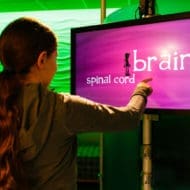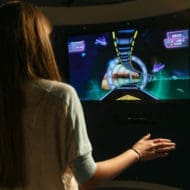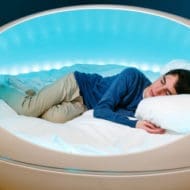If you caught our recent article on kids and teens with pain, you know that it’s a growing problem. Maybe you’re the parent of a child dealing with frequent headaches or stomach pain (two of the most common kinds for this age group) or maybe you’re a teenager with daily pain.
 As a pediatric anesthesiologist and clinical director of the Pain Medicine Care Complex at the Children’s National Medical Center, in Washington, Dr. Sarah Rebstock, M.D., sees plenty of young people suffering, as well as frustrated and anxious parents who’d do anything to help.
As a pediatric anesthesiologist and clinical director of the Pain Medicine Care Complex at the Children’s National Medical Center, in Washington, Dr. Sarah Rebstock, M.D., sees plenty of young people suffering, as well as frustrated and anxious parents who’d do anything to help.
“Parents are shocked to find that there’s not one solution, shot, or procedure that can stop [their child’s pain] and that there’s ‘nothing wrong’ with their child,” she says, referring to the common lack of understanding that pain itself can be a pathology, even without a discernible underlying problem. “It’s the nervous system malfunctioning,” Rebstock says.
Kids and teens in pain face some big challenges. For one, there are few centers or even physicians specializing in pediatric pain, according to Rebstock. “It’s very hard to find [outside some of the larger U.S. cities], and what’s even harder to find is a center that will treat the whole patient, with a multidisciplinary approach,” she says.
Treating kids’ bodies, minds, and emotions is something at which the Children’s National Medical Center excels and is consistently innovating. For example, one of the barriers to treating kids and adolescents can be assessing how much discomfort they’re in and what type of pain they have in other words, getting an accurate diagnosis.
“Pain is currently a very subjective thing. Rebstock says. You tell me, from zero to 10, what’s your pain [level],” Rebstock says. “For one kid, it’s nine  out of 10; and another kid says it’s 100 out of 10. How do I use that scale to [get an accurate measure]?”
out of 10; and another kid says it’s 100 out of 10. How do I use that scale to [get an accurate measure]?”
To get a better answer, the center uses several techniques, including its “multisensory room.” It includes interactive video games that employs Kinect and other technologies, along with real-time motion-tracking. While the kids play the game, move, and answer questions, the technology gathers the tracking information.
“It measures your range of motion, your ability to do so many reps of something in a minute, your facial expressions,” and heart rate and skin temperature, Rebstock says. The result is powerful: “We can objectively measure pain function. And we can intervene based on that number,” she says.
Even better, the multisensory approach is therapeutic. It helps target whether young patients are moving properly or if aches are hindering their ability to move, and can even add sensory enhancements, such as the smell of peppermint, which helps soothe stomach pain.
The whole experience taps into the brain’s neuroplasticity, says Rebstock.
“We’re trying to distract the brain, she says. We can change how the signal is coming in. For example, by distracting the brain with different scents that turn on different parts, we’re trying to stimulate the brain in different ways.”
The center also uses a “pod bed” from Alberto Frias, who designed the furniture in the film Men in Black III.
“It’s a giant biofeedback device,” Rebstock says. “There’s a subwoofer underneath it, the color changes based on body temperature, and the lights can be made to flash according to the patient’s heart rate. The bed responds to them so you get data from the patient as we’re doing relaxation or treatment.”
 One of the most exciting developments at the center is a device developed by Dr. Julia Finkel, M.D., leader of the Pain Medicine Initiative in the Sheikh Zayed Institute for Pediatric Surgical Innovation. Called an algometer, it measures pain.
One of the most exciting developments at the center is a device developed by Dr. Julia Finkel, M.D., leader of the Pain Medicine Initiative in the Sheikh Zayed Institute for Pediatric Surgical Innovation. Called an algometer, it measures pain.
It is currently being studies by the FDA, and we’re working in tandem with Dr. Finkel to put [the algometer] together with the information that is already being gathered about youngsters at the Center. “With this objective data to measure we can say, ‘This kid has these types of pain,’ ” Rebstock says, adding that algometer can measure pain even in infants.
But even with all the high-tech innovations, Rebstock thinks a pain-management program that treats the whole patient and the whole family is the most important part of the Center’s work.
“What works for families is taken into consideration right away,” she says. “People need a multidisciplinary approach treating the whole person. We embrace complementary and alternative medicine not as a replacement for anything but because they are supportive therapies.”
Ultimately, Rebstock would like to see many more kids with access to this innovative, holistic treatment, partly to keep them from becoming adults with pain.
“My goal is to have every kid who needs it to have access, she says. I want to shrink what we’re doing down to the size of a computer, to have a device that can be set up to track data from anywher”see their range of motion, know what kind of pain they’re having and changing therapies from [a distance.]”
Does your child have pain? Have you been able to find effective treatment?
Photos courtesy of the Pain Medicine Care Complex, Children’s National Medical Center

